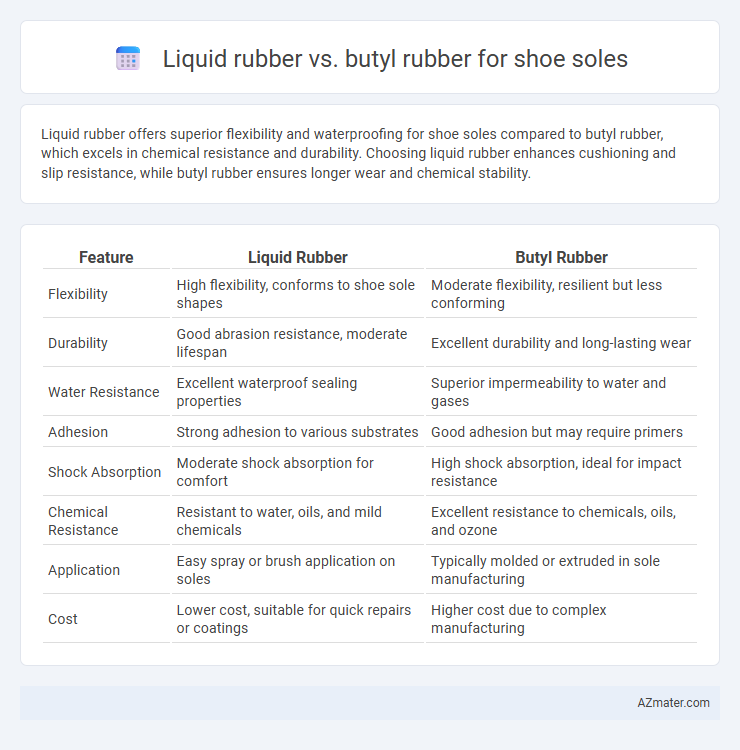Liquid rubber offers superior flexibility and waterproofing for shoe soles compared to butyl rubber, which excels in chemical resistance and durability. Choosing liquid rubber enhances cushioning and slip resistance, while butyl rubber ensures longer wear and chemical stability.
Table of Comparison
| Feature | Liquid Rubber | Butyl Rubber |
|---|---|---|
| Flexibility | High flexibility, conforms to shoe sole shapes | Moderate flexibility, resilient but less conforming |
| Durability | Good abrasion resistance, moderate lifespan | Excellent durability and long-lasting wear |
| Water Resistance | Excellent waterproof sealing properties | Superior impermeability to water and gases |
| Adhesion | Strong adhesion to various substrates | Good adhesion but may require primers |
| Shock Absorption | Moderate shock absorption for comfort | High shock absorption, ideal for impact resistance |
| Chemical Resistance | Resistant to water, oils, and mild chemicals | Excellent resistance to chemicals, oils, and ozone |
| Application | Easy spray or brush application on soles | Typically molded or extruded in sole manufacturing |
| Cost | Lower cost, suitable for quick repairs or coatings | Higher cost due to complex manufacturing |
Introduction: Choosing the Right Sole Material
Liquid rubber offers excellent flexibility and waterproof properties, making it ideal for shoe soles requiring durability and comfort. Butyl rubber provides superior air retention and resistance to chemicals, suited for soles needing long-lasting cushioning and protection. Selecting between liquid and butyl rubber depends on specific performance requirements such as flexibility, abrasion resistance, and environmental factors.
What Is Liquid Rubber?
Liquid rubber is a versatile, polymer-based coating known for its flexible, waterproof, and durable properties, making it an excellent choice for shoe soles requiring resilience and slip resistance. Unlike butyl rubber, which is a synthetic rubber known for its airtight and chemical-resistant qualities, liquid rubber is applied as a liquid and cures into a seamless, protective layer that can easily conform to intricate sole designs. Its seamless application reduces the risk of cracks and enhances the elasticity and durability of shoe soles, providing comfort and long-lasting wear.
What Is Butyl Rubber?
Butyl rubber is a synthetic rubber known for its exceptional impermeability to gases and excellent resistance to heat, chemicals, and abrasion, making it a durable material for shoe soles. Unlike liquid rubber, which is a versatile coating that can be applied in thin layers, butyl rubber offers superior cushioning and shock absorption, enhancing comfort and longevity. Its unique polymer structure allows it to maintain flexibility and resilience in extreme conditions, making it a preferred choice for high-performance footwear.
Durability Comparison: Liquid Rubber vs Butyl Rubber
Liquid rubber exhibits superior flexibility and resilience, making it highly durable against repetitive bending and abrasion in shoe soles. Butyl rubber offers exceptional impermeability to air and moisture, ensuring long-term protection and resistance to environmental factors but may be less flexible under extreme conditions. When comparing durability, liquid rubber generally outperforms butyl rubber in maintaining elasticity and wear resistance, while butyl rubber excels in providing a robust barrier against external elements.
Flexibility and Comfort for Shoe Soles
Liquid rubber offers exceptional flexibility, molding seamlessly to the foot's contours, enhancing comfort by reducing pressure points in shoe soles. Butyl rubber, known for its durability and low gas permeability, provides moderate flexibility but may feel stiffer compared to liquid rubber. For shoe soles prioritizing comfort and adaptability during prolonged wear, liquid rubber delivers superior cushioning and flexibility over butyl rubber.
Waterproofing Capabilities
Liquid rubber offers superior waterproofing capabilities for shoe soles due to its ability to form a seamless, flexible barrier that prevents water penetration even under prolonged exposure. Butyl rubber, known for its excellent impermeability and resistance to gas and moisture, provides durable waterproofing but can be less flexible and prone to cracking over time. The choice between liquid rubber and butyl rubber hinges on the balance between flexibility and long-term waterproof durability required for specific shoe applications.
Grip and Slip Resistance
Liquid rubber offers superior grip and slip resistance for shoe soles due to its excellent flexibility and ability to form a consistent, textured surface, which enhances traction on various terrains. Butyl rubber provides moderate slip resistance with good durability but may lack the same level of flexibility and texture variation as liquid rubber, resulting in less effective grip on wet or slippery surfaces. For optimal shoe sole performance, liquid rubber's advanced slip-resistant properties make it the preferred choice in high-grip applications.
Environmental Resistance: Temperature and Chemicals
Liquid rubber offers superior flexibility and maintains performance under extreme temperature fluctuations, making it highly resistant to cracking in cold or heat. Butyl rubber excels in chemical resistance, particularly against oils, acids, and ozone, ensuring durability in harsh chemical environments. For shoe soles, liquid rubber provides enhanced temperature resilience while butyl rubber offers prolonged protection against chemical exposure.
Cost-Effectiveness and Manufacturing Ease
Liquid rubber offers superior cost-effectiveness for shoe soles due to lower raw material expenses and reduced processing time, enabling faster production cycles. Butyl rubber, although more expensive, provides excellent durability and resistance to chemicals but requires more complex molding techniques and longer curing periods. Manufacturers often prefer liquid rubber for high-volume, budget-sensitive footwear while opting for butyl rubber when prioritizing longevity and premium performance.
Which Rubber Material Wins for Shoe Soles?
Liquid rubber offers exceptional flexibility and superior abrasion resistance, making it ideal for dynamic shoe soles that require frequent bending and impact absorption. Butyl rubber excels in waterproofing and chemical resistance, providing durability against environmental factors and long-term wear. For shoe soles, liquid rubber generally wins due to its enhanced elasticity and comfort, which are critical for daily wear and athletic performance.

Infographic: Liquid rubber vs Butyl rubber for Shoe sole
 azmater.com
azmater.com